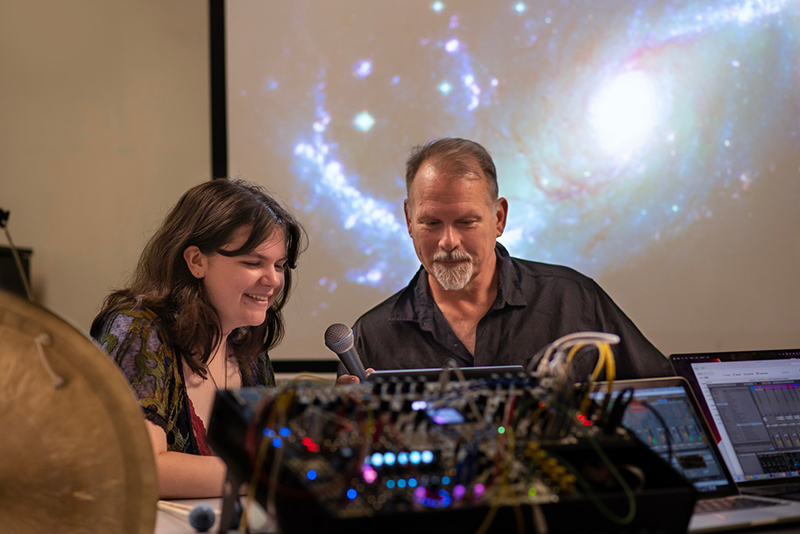Arresting Views—Music and Images Inspired by Astronomy
The multimedia performance is the result of a student-faculty collaboration that started this summer and features vocals, electronic sounds, and interactive visual media.

Stevie Lyles '26 and music professor Ken Schweitzer work with recording equipment
in front of a projection of an image from the James Webb Space Telescope.
The Department of Music is excited to present Arresting Views, a performance that explores the hidden facets of human existence through a blend
of vocals, electronic sounds, and interactive visual media, offering a unique and
fascinating experience for attendees this Wednesday, December 6 at the Decker Auditorium.
The performance is a collaborative project by Associate Professor Ken Schweitzer and Stevie Lyles '26. The two share an interest with the vast expanse of outer space and experience with digital audio production software.
While space may seem like an unlikely inspiration for a musical performance, Arresting Views transcends the norms of traditional performances by offering an immersive audiovisual experience incorporating various elements such as projections, live video editing software, modular synthesizers, and vocal performances by Lyles herself.
Looking to the stars, Lyles and Schweitzer initially knew they wanted to create a live performance inspired by NASA's Chandra X-ray Observatory and James Webb Space Telescope. The four composite images, also named Arresting Views, show distant galaxies and star clusters previously invisible to the human eye. In awe of the images, Lyles immediately knew she wanted to incorporate them into the performance.
“As soon as I saw them for the first time, something about them really just invoked a certain powerful feeling that I couldn't forget,” Lyles said. “The title is what stuck with me as well. I view Arresting Views as a type of fight to prove our existence, and our understanding of our existence.”
To create this enchanting experience, the duo utilized the Ableton Live Software to develop their vision. Lyles uses the software to develop vocal harmonies, to sample and re-trigger her voice, and to explore of variety of effects including reverb, delay, and distortion. Schweitzer uses Ableton on two computers, one to manipulate the images in real-time and the other to process the sounds coming from a modular synthesizer, which is a largely analog device consisting of oscillators, filters, samplers, sequencers, and a variety other bit of electronic circuitry.
“In each of the four movements, Stevie and I deconstruct the composite images and re-synthesize them in new and creative ways,” Schweitzer said. “As the images continually evolve, we respond by generating layers of electronic and acoustic sounds. Our performance is improvisatory and impressionistic, but also poetic and lyrical.”
Arresting Views is an exploration of the connection between the universe and humanity, but also highlights the incredible work undertaken by Lyles and Schweitzer over the course of several months and the collaborative opportunities available to both students and faculty at Washington College. The project began this summer as one of 10 Hodson Collaborative Undergraduate Research Grants, which fund joint work by faculty and students in the arts, humanities and social sciences.
“I'm incredibly thankful and lucky to have had this opportunity working with Dr. Schweitzer. It's really interesting being able to work more as colleagues in this project while also being student and mentor,” Lyles said. “I'm able to freely share and develop my own thoughts, and my ideas are taken very seriously in the environment. I think we've both worked super hard to create something that we're really proud to share.”
The performance is scheduled for December 6 from 7:30 p.m. to 8:30 p.m. in Decker Auditorium at the Daniel Z. Gibson Center and is a free event, courtesy of the music department. To learn more about the event, or to check out other upcoming performances, visit the calendar of Performing Arts and Exhibitions.
Lyles is optimistic for how the audience will interact with the performance and visual components.
“We are working to bridge the gap between the arts and sciences as well as humanity and the universe's wide expanse,” she said. “Our overall goal is to provide a new way of understanding an almost inconceivable subject, so if people leave the performance with more questions than they came with, I think that could be a win in itself.”
— Emma Poole